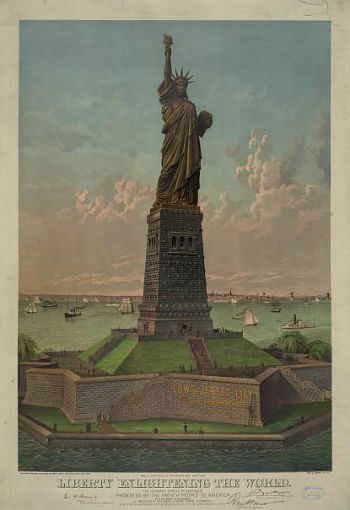
Early HistoryPre-1000 CENative Americans inhabit the land that is now Liberty Island. This island is one of the three "Oyster Islands" in New York Harbor, for the numerous shell beds in this location and a major source of food.
1609Henry Hudson lands in New York Harbor and the Hudson River estuary. Europeans begin to colonize the area which includes the Oyster Islands. Occupation, war, and disease during colonization force the Native Americans to move both north and west.
1667Isaac Bedloe, a Dutch colonist, obtains ownership of Oyster Island.
1670Colonial Governor Francis Lovelace provides a land grant to Bedloe, noting Bedloe's desire to rename the island to "Love Island."
1673Bedloe dies, Governor Lovelace is overthrown by the Dutch navy, and Love Island is renamed Bedloe's Island.
1674The English take over Bedloe's Island.
1732Mary Bedloe Smith (Isaac's widow) sells Bedloe's Island to Adolph Philipse and Henry Lane, New York merchants, to get out of bankruptcy.
1738New York City takes possession of the island, using it as a quarantine station, inspecting incoming ships for contamination and disease.
1746Archibald Kennedy (later 11th Earl of Cassiles) purchases the island and establishes a summer residence.
1755-1757Bedloe's Island is reestablished as a quarantine station due to the outbreak of smallpox.
1758Ownership of Bedloe's Island is again granted to New York City.
1759-1760A hospital is constructed on Bedloe's Island.
1772-1776During the American Revolution, the island is used as an asylum for Tory sympathizers (American colonists loyal to Great Britain during the war).
1776Colonial insurgents lay siege Bedloe's Island and burn its buildings.
1784The New York state legislature passes an act once again making the island a quarantine station.
1793-1796The French (allies of the Patriots during the war) use Bedloe's Island as an isolation station.
1794After the events of the American Revolution, and the rising tensions between the United States, England, and France, federal dollars are appropriated to construct fortifications on Bedloe's Island.
1808The United States Army administers Bedloe's Island as a military post until 1937. Construction on the "Works on Bedloe's Island," later known as Fort Wood, begins. The 11-point star fort aids in the protection of the New York Harbor. It is garrisoned with artillery and infantry until the outbreak of the Civil War.
1811The "Works on Bedloe's Island" is completed.
1814The "Works on Bedloe's Island," is renamed Fort Wood by New York Governor Daniel D. Tompkins in the memory of Eleazer D. Wood, an army hero killed in action at Fort Erie.
1834An interstate agreement between New York and New Jersey places Bedloe's Island (the land above low level water mark) within New York while New Jersey retains riparian rights to waters and all submerged land surrounding the island.
1861The United States Civil War begins and Fort Wood serves as a recruiting station and ordinance depot. A small garrison is maintained at the fort.
1877The garrison at Fort Wood is disbanded. However, the United States Army continues to supervise an ordnance post (and remains active) on Bedloe's Island until 1937.
Bedloe's Island is designated as the site for the Statue of Liberty. 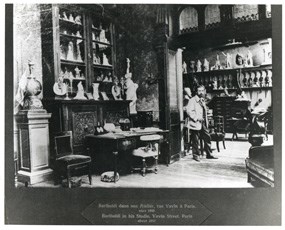
National Park Service, Statue of Liberty National Monument The Origins of the Statue of LibertyThe Statue of Liberty is more than a monument; she is a beloved friend and living symbol of freedom to millions of people worldwide.
1865Edouard de Laboulaye, a French political intellectual and authority on the U.S. Constitution, proposes that France give a statue representing liberty to the United States for its centennial. The recent Union victory in the American Civil War reaffirms the United States' ideals of freedom and democracy, serving as a platform for Laboulaye to argue that honoring the United States would strengthen the cause for democracy in France.
1870Auguste Bartholdi, a young sculptor fascinated with the idea of creating colossal works, enthusiastically supports Laboulaye's proposed statue and becomes the sculptor of the Statue of Liberty.
1871Bartholdi comes to the United States to promote the Statue and scout out possible sites. In his travels, Bartholdi discusses the project with politicians and publishers.
1872Bartholdi returns to France and reports on having found interest in the project as well as the perfect site - Bedloe's Island located in New York Harbor.
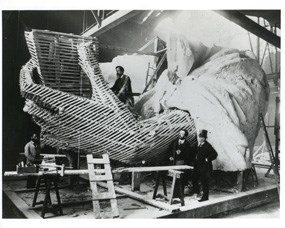
National Park Service, Statue of Liberty National Monument The Statue in France
1875Bartholdi's plaster model of the Statue, referred to as "The Statue of Liberty Enlightening the World," is approved by Laboulaye.
Laboulaye makes a formal request to President Ulysses S. Grant for using Bedloe's Island as the Statue's official site. The Franco-American Union is formed in France to oversee fundraising for the Statue. The Statue of Liberty's creators strongly feel that the project should be a joint French-American effort: the French agree to fund the Statue if the people of the United States fund the pedestal. Between 1875 and 1880, the French committee raises about 400,000 francs. 1876Bartholdi begins constructing the Statue.
Bartholdi completes the Statue's hand holding the torch. This section of the Statue is sent to the United States and displayed at the Centennial Exposition in Philadelphia on May 18th.
1877After being part of the Centennial Exposition in Philadelphia, the Statue's torch is displayed at Madison Square in New York City. It remains there until 1882.
February 22nd - The U.S. Congress accepts the Statue of Liberty as a gift from the people of France. March 3rd - President Ulysses S. Grant signs a bill designating Bedloe's Island as the Statue's site. The United States begins fundraising for the construction of the pedestal through the American Committee for the Statue of Liberty, which is chaired by William Maxwell Evarts. Bartholdi's friend, Richard Butler, is also heavily involved. The committee raises $125,000 between 1877 and 1884. 1878The Statue's head and shoulders are completed and displayed for the first time at the Paris Universal Exposition.
1879The Statue's engineer, Eugene Viollet-le-Duc, dies and Bartholdi hires Alexandre-Gustave Eiffel to complete the project and overcome various obstacles concerning the Statue's structure and assembly. The obstacles include the Statue's height, weight, unusual shape, and the high winds in New York harbor.
1880Eiffel devises his ingenious support system: a 98 foot (29.87 meters) inner iron framework that will support the Statue's structure.
1881The Statue's copper plates are completed and the first rivet is driven into the structure. This begins the Statue's assembly and completion. As the Statue is gradually built near the Parc Monceau, in Paris, the French people fall in love with her. She is referred to as the "Lady of the Park."
The American Committee for the Statue of Liberty commissions American architect Richard Morris Hunt to design the pedestal; within months he submits a detailed plan. 1883The Statue's assembly continues in Paris and work begins on the 15 foot deep foundation for the pedestal on Bedloe's Island. General Charles P. Stone is appointed as Chief Engineer, responsible for design and construction of the concrete foundation and the construction of the pedestal.
Edouard de Laboulaye dies. November 2nd - Emma Lazarus composes "The New Colossus" for the "Art Loan Fund Exhibition in Aid of the Bartholdi Pedestal Fund for the Statue of Liberty" - a fundraiser for the pedestal. 1884Hunt completes his finalized plan for the pedestal, with poured concrete walls up to 20 feet thick, faced with granite blocks. The concrete mass is the largest mass of poured concrete at that time. The pedestal's cornerstone is laid on Bedloe's Island.
July 4th - hundreds of people gather at the feet of the completed Statue in Paris to watch as she is formally presented to Levi P. Morton, the U.S. minister to France. A crisis occurs in the United States. The Statue is scheduled to arrive in the United States in 1885, but funds for the pedestal project run out and work on the pedestal stops. 1885New York World publisher, Joseph Pulitzer, comes to the Statue's financial rescue with a highly successful, six-month fund raising campaign. Over $100,000 is raised. 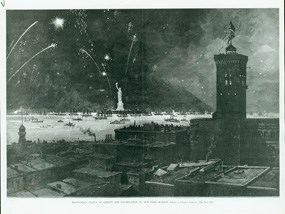
National Park Service, Statue of Liberty National Monument The Statue in America1886The Statue's pedestal is completed.
The American Committee for the Statue of Liberty signs a contract with D.H. King of New York to begin construction work on the Statue. This begins the difficult and dangerous task of reassembling the Statue on Bedloe's Island. The crews, most of whom are immigrants, assemble the Statue with great precision and speed. The decision is made to light the Statue's torch electrically. The Army Corps of Engineers vetoes putting flood lights on the torch's balcony so Bartholdi cuts portholes in the torch and put lights inside of them. October 10th - President Grover Cleveland places the Statue and pedestal under the administration of the U.S. Lighthouse Board as maritime structures. October 15th - The remaining fingers clasping the handle of the torch are installed. October 20th - A heavy canvas is dropped over the Statue's face in preparation for the inaugural celebration. Although this spoils the view for many early visitors, the mask stays on until the Statue's unveiling. October 23rd - The Statue of Liberty is completed. October 28th - New York City holds the first Ticker-Tape Parade in honor of the dedication of the statue of 'Liberty Enlightening the World' which over one million people attend. A water parade of approximately 300 vessels passes in front of the Statue even though visibility is less than a quarter of a mile due to fog and rain throughout the day. The Statue of Liberty is formally unveiled at the dedication ceremony on Bedloe's Island which was attended by 2,000-2,500 men. The New York State Woman Suffrage Association, unable to obtain tickets to the dedication as they were unaccompanied woman, charters a boat to view the island ceremonies from the water. During the ceremony, Bartholdi releases the tricolor French flag draped across the Statue's face prematurely and guns sound and people begin to whistle and applaud. President Grover Cleveland formally accepts the Statue of Liberty on behalf of the United States of America as a gift of friendship from France. President Cleveland salutes Bartholdi as "the greatest man in America today." November 1st - The fireworks display and illumination of the Statue of Liberty, cancelled on October 28 due to the inclement weather, takes place. 1888Double spiral cast-iron stairs are added to the interior of the Statue.
1901Control of the Statue is transferred from the Lighthouse Board to the U.S. War Department.
1903Words from Emma Lazarus' poem "The New Colossus" are inscribed on a plaque and mounted to the base of the Statue.
1907The first elevator, ordered from the Otis Elevator Co, is installed in the Statue.
1916The Statue of Liberty is illuminated for the first time.
1918First repairs are made to the Statue's copper skin.
1924The Statue is designated a National Monument by President Calvin Coolidge by authority of the Antiquities Act.
1933The Statue is transferred to the Department of the Interior's National Park Service (along with other National Monuments) by President Franklin D. Roosevelt.
1936October 28th - President Franklin D. Roosevelt presides over the celebration of the Statue's 50th anniversary on Bedloe's Island.
1937The War Department relinquishes control of the remainder of Bedloe's Island. National Park Service begins development of a master plan for the island to complement the Statue of Liberty.
1939The Master Plan for Liberty Island is completed and implementation begins.
1942-1945The Statue's torch is extinguished under the blackout regulations of World War II. Visitors are still allowed to visit the Statue.
1952Plans begin for the new American Museum of Immigration, to be built inside the base of the pedestal.
1956Bedloe's Island is renamed Liberty Island by a joint resolution in Congress and signed into law by President Dwight D. Eisenhower.
1962Construction begins on the American Museum of Immigration.
1965October 3rd - President Lyndon B. Johnson signs the Immigration and Nationality Act of 1960 at Liberty Island. The bill abolishes the national origins quota system and states that all who wish to immigrate to America shall be "admitted on the basis of their skills and their close relationships to those already there."
May 11th - President Johnson signs a Presidential Proclamation, adding Ellis Island to the National Park Service, under the administration of the Statue of Liberty National Monument. 1971The group, Vietnam Veterans Against the War, occupy the Statue of Liberty for three days to protest the Vietnam War.
1972President Richard Nixon opens the American Museum of Immigration.
1977October 25th - Puerto Rican nationalists drape the Puerto Rican flag across the Statue's forehead in an illegal demonstration.
1980June 3rd - A time delayed bomb detonates in the base of the Statue of Liberty. The FBI suspects Croatian Nationalists advocating Croatian independence from Yugoslavia. Although no one is injured, the National Park Service increases security measures.
1982Demonstrators opposing the U.S. military intervention in Grenada chain themselves to the support structure of the Statue's crown.
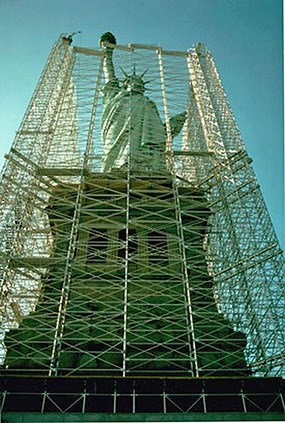
National Park Service, Statue of Liberty National Monument The Statue's 1980s RestorationDuring its first one hundred years, the Statue of Liberty underwent numerous renovations. The most extensive was the restoration of the 1980s.1982President Ronald Reagan appoints Lee Iacocca to head a private foundation to restore the Statue of Liberty.1983The French-American Committee for Restoration of the Statue of Liberty, Inc. publishes its Architectural and Engineering Report. This report assesses the current condition of the Statue and provides designs for needed restoration.1984Restoration of the Statue begins. This work is carried out through a collaboration between the National Park Service and the Statue of Liberty - Ellis Island Foundation. Changes include the replacement of the rusted iron armature bars with stainless steel bars; the removal of multiple coatings from the interior copper skin; and the construction of a new torch covered with gold leaf.1985A shell midden stratum containing shells, pottery fragments, and projectile points is uncovered on Liberty Island during restoration.1986Renovation work is completed on the Statue.July 4th - The United States joyfully celebrates Liberty Weekend. July 5th - The Statue of Liberty National Monument re-opens, including a new Statue of Liberty Exhibit in the pedestal. October 28th - The centennial of the Statue of Liberty is officially celebrated with officials from France and the United States. 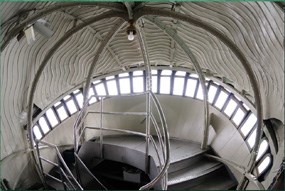
National Park Service, Statue of Liberty National Monument Recent History2001September 11th - The first Statue of Liberty ferry was preparing to depart for the day just as the World Trade Center came under attack. The ferry was turned back and no visitors reached Liberty Island.December 1st - Liberty Island reopens to the public but the inside of the monument remains closed. 2004August 3rd - The inside of the pedestal reopens to the public.2009July 4th - The Statue's crown reopens to the public for the first time since September 2001.2011October 28th - The Statue of Liberty National Monument celebrates 125 years of "Liberty Enlightening the World."October 29 - The interior of the Statue of Liberty's pedestal closes for a year long renovation. 2012October 28 - The inside of the Statue of Liberty reopens after a year long renovation.October 29 - Flooding from Hurricane Sandy covers 75% of Liberty Island. Major infrastructure is damaged. Liberty Island closes until repairs can be made. 2013July 4 - The Statue and Liberty Island reopen to the public while repairs continue to Liberty Island. |
Last updated: May 4, 2023
